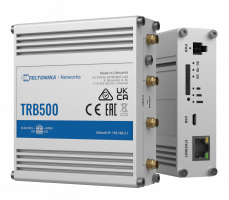
El TRB500 es un gateway industrial bajo tecnología 5G de tamaño reducido y bajo consumo con un puerto Gigabit Ethernet y dos I/O configurables que puede ser aplicado a multitud de escenarios de uso.
Este dispositivo permite la conexión a velocidades 5G con muy baja latencia haciéndolo especialmente indicado para aplicaciones críticas o de alta demanda de caudal gracias a sus 4 antenas externas que permiten el uso de configuraciones 4×4 MIMO.
El TRB500 viene equipado con el RutOS, un sistema operativo propio de Teltonika que proporciona funcionalidades avanzadas en seguridad, incorpora protocolos industriales como Modbus, MQTT entre otro y es compatible con la plataforma Remote Management System (RMS) para acceso remoto y monitorización de grandes volúmenes de dispositivos..
| MOBILE | |
| Mobile module | 5G Sub-6Ghz SA/NSA 2.1/3.3Gbps DL (4×4 MIMO), 900/600 Mbps UL (2×2); 4G (LTE) – LTE Cat 20 2.0Gbps DL, 200Mbps UL; 3G – 42 Mbps DL, 5.76Mbps UL |
| Status | Signal strength (RSSI), SINR, RSRP, RSRQ, EC/IO, RSCP Bytes sent/received, connected band, IMSI, ICCID. |
| SMS/Call | SMS status, SMS configuration, send/read SMS via HTTP POST/GET, EMAIL to SMS, SMS to EMAIL, SMS to HTTP, SMS to SMS, scheduled SMS, SMS autoreply, Call utilities |
| USSD | Supports sending and reading Unstructured Supplementary Service Data messages |
| Black/White list | Operator black/white list |
| Band management | Band lock, Used band status display |
| APN | Auto APN |
| Bridge | Direct connection (bridge) between mobile ISP and device on LAN |
| Passthrough | Gateway assigns its mobile WAN IP address to another device on LAN |
| ETHERNET | |
| LAN | 1 x RJ45 port, 10/100/1000 Mbps, supports auto MDI/MDIX crossover |
| NETWORK | |
| Network protocols | TCP, UDP, IPv4, IPv6, ICMP, NTP, DNS, HTTP, HTTPS, SMTP, SSL v3, TLS, PPP, PPPoE, SSH, DHCP, SNMP, MQTT, Wake on LAN (WOL) |
| Routing | Static routing, Dynamic routing (BGP, OSPF v2, RIP v1/v2, EIGRP, NHRP) |
| Connection monitoring | Ping Reboot, Wget Reboot, Periodic Reboot, LCP and ICMP for link inspection |
| Firewall | Port forwards, traffic rules, custom rules |
| DHCP | Static and dynamic IP allocation |
| DDNS | Supported >25 service providers, others can be configured manually |
| SSHFS | Possibility to mount remote file system via SSH protocol |
| SECURITY | |
| Authentication | Pre-shared key, digital certificates, X.509 certificates |
| Firewall | Pre-configured firewall rules can be enabled via the WebUI, unlimited firewall configuration via CLI; NAT; NAT-T |
| Attack prevention | DDOS prevention (SYN flood protection, SSH attack prevention, HTTP/HTTPS attack prevention), port scan prevention (SYN-FIN, SYN-RST, X-mas, NULL flags, FIN scan attacks) |
| VLAN | Port and tag-based VLAN separation |
| Mobile quota control | Set up custom data limits for SIM card |
| WEB filter | Blacklist for blocking out unwanted websites, Whitelist for specifying allowed sites only |
| Access control | Flexible access control of TCP, UDP, ICMP packets, MAC address filter |
| VPN | |
| OpenVPN | Multiple clients and a server can run simultaneously, 12 encryption methods |
| OpenVPN Encryption | DES-CBC, RC2-CBC, DES-EDE-CBC, DES-EDE3-CBC, DESX-CBC, BF-CBC, RC2-40-CBC, CAST5-CBC, RC2-64-CBC, AES-128-CBC, AES-192-CBC, AES-256-CBC |
| GRE | GRE tunnel |
| IPsec | IKEv1, IKEv2, supports up to 5 x VPN IPsec tunnels (instances), with 5 encryption methods (DES, 3DES, AES128, AES192, AES256) |
| PPTP, L2TP | Client/Server services can run simultaneously, L2TPv3 support |
| SSTP | SSTP client instance support |
| STUNNEL | Proxy designed to add TLS encryption functionality to existing clients and servers without any changes in the program’s code |
| DMVPN | Method of building scalable IPsec VPNs |
| WireGuard | WireGuard VPN client and server support |
| ZeroTier | ZeroTier VPN |
| MODBUS | |
| MODBUS TCP SLAVE | |
| ID filtering | Respond to one ID in range [1;255] or any |
| Allow remote access | Allow access through WAN |
| Custom registers | MODBUS TCP custom register block, which allows to read/write to a file inside the router, and can be used to extend MODBUS TCP slave functionality |
| MODBUS TCP MASTER | |
| Supported functions | 01, 02, 03, 04, 05, 06, 15, 16 |
| Supported data formats | 8 bit: INT, UINT; 16 bit: INT, UINT (MSB or LSB first); 32 bit: float, INT, UINT (ABCD (big-endian), DCBA (little-endian), CDAB, BADC), HEX, ASCII |
| MQTT GATEWAY | |
| Gateway | Allows sending commands and receiving data from MODBUS Master through the MQTT broker |
| DNP3 | |
| Supported modes | TCP Master, DNP3 Outstation |
| DATA TO SERVER | |
| Protocol | HTTP(S), MQTT, Azure MQTT, Kinesis |
| MONITORING & MANAGEMENT | |
| WEB UI | HTTP/HTTPS, status, configuration, FW update, CLI, troubleshoot, system log, kernel log |
| FOTA | Firmware update from sever, automatic notification |
| SSH | SSH (v1, v2) |
| SMS | SMS status, SMS configuration, send/read SMS via HTTP POST/GET |
| Call | Reboot, Status, Mobile data on/off, Output on/off, answer/hang-up with a timer |
| TR-069 | OpenACS, EasyCwmp, ACSLite, tGem, LibreACS, GenieACS, FreeACS, LibCWMP, Friendly tech, AVSystem |
| MQTT | MQTT Broker, MQTT publisher |
| SNMP | SNMP (v1, v2, v3), SNMP trap |
| JSON-RPC | Management API over HTTP/HTTPS |
| MODBUS | MODBUS TCP status/control |
| RMS | Teltonika Remote Management System (RMS) |
| IoT PLATFORMS | |
| Cloud of Things | Allows monitoring of: Device data, Mobile data, Network info, Availability |
| ThingWorx | Allows monitoring of: WAN Type, WAN IP Mobile Operator Name, Mobile Signal Strength, Mobile Network Type |
| Cumulocity | Allows monitoring of: Device Model, Revision and Serial Number, Mobile Cell ID, ICCID, IMEI, Connection Type, Operator, Signal Strength, WAN Type and IP |
| Azure IoT Hub | Can send device IP, Number of bytes send/received/ 3G connection state, Network link state, IMEI, ICCID, Model, Manufacturer, Serial, Revision, IMSI, Sim State, PIN state, GSM signal, WCDMA RSCP WCDMA EC/IO, LTE RSRP, LTE SINR, LTE RSRQ, CELL ID, Operator, Operator number, Connection type, Temperature, PIN count to Azure IoT Hub server |
| SYSTEM CHARACTERISTICS | |
| CPU | Single core ARM Cortex A7, 1.5 GHz |
| RAM | 256 MB (128 MB available for userspace) |
| FLASH storage | 512 MB (200 MB available for userspace) |
| FIRMWARE / CONFIGURATION | |
| WEB UI | Update FW from file, check FW on server, configuration profiles, configuration backup |
| FOTA | Update FW |
| RMS | Update FW/configuration for multiple devices |
| Keep settings | Update FW without losing current configuration |
| FIRMWARE CUSTOMIZATION | |
| Operating system | RutOS (OpenWrt based Linux OS) |
| Supported languages | Busybox shell, Lua, C, C++ |
| Development tools | SDK package with build environment provided |
| INPUT/OUTPUT | |
| Configurable I/O | 2 x Configurable Inputs/Outputs. Digital input 0 – 5 V detected as logic low, 8 – 40 V detected as logic high. Open collector output, max output 30 V, 300 mA |
| Output control | HTTP POST/GET, Schedule |
| Events | SMS, EMAIL |
| I/O juggler | Allows setting certain I/O conditions to initiate event |
| POWER | |
| Connector | 4-pin industrial DC power socket |
| Input voltage range | 9 – 30 VDC, reverse polarity protection, surge protection >33 VDC 10us max |
| Power consumption | Idle: <3 W, Max <6 W |
| PHYSICAL INTERFACES (PORTS, LEDS, ANNTENAS, BUTTONS, SIM) | |
| Ethernet | 1 x RJ45 port, 10/100/1000 Mbps |
| I/Os | 2 x Configurable I/O pins on 4-pin power connector |
| USB | 1 x Virtual network interface via micro USB |
| Status LEDs | 3 x connection type status LEDs, 3 x connection strength LEDs, 2 x LAN status LEDs, 1 x Power LED |
| SIM | 1 x SIM slot (Mini SIM – 2FF), 1.8 V/3 V |
| Power | 1 x 4-pin DC power connector |
| Anntena | 4 x SMA for Mobile |
| Reset | Reboot/User default reset/Factory reset button |
| Grounding | Grounding screw terminal |
| PHYSICAL SPECIFICATIONS | |
| Casing material | Aluminum housing |
| Dimensions (W x H x D) | 100 x 30 x 93,4 mm |
| Weight | 241g |
| Mounting options | DIN rail, Flat surface |
| OPERATING ENVIRONMENT | |
| Operating temperature | -40 °C to 75 °C |
| Operating humidity | 10 % to 90 % non-condensing |
| Ingress Protection Rating | IP30 |

